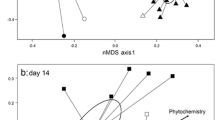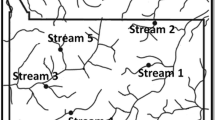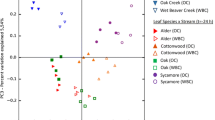Abstract
Microorganisms mediate the decomposition of leaf-litter through the release of extracellular enzymes. The surfaces of decomposing leaves are both chemically and physically heterogeneous, and spatial patterns in microbial enzyme activity on the litter surface should provide insights into fine-scale patterns of leaf-litter decomposition. Platanus occidentalis leaves were collected from the floodplain of a third-order stream in northern Mississippi, enclosed in individual litter bags, and placed in the stream channel and in the floodplain. Replicate leaves were collected approximately monthly over a 9-month period and assayed for spatial variation in microbial extracellular enzyme activity and rates of organic matter (OM) decomposition. Spatial variation in enzyme activity was measured by sampling 96 small discs (5-mm diameter) cut from each leaf. Discs were assayed for the activity of enzymes involved in lignin (oxidative enzymes) and cellulose (β-glucosidase, cellobiohydrolase) degradation. Rates of OM loss were greater in the stream than the floodplain. Activities of all enzymes displayed high variability in both environments, with severalfold differences across individual leaves, and replicate leaves varied greatly in their distribution of activities. Geostatistical analysis revealed no clear patterns in spatial distribution of activity over time or among replicates, and replicate leaves were highly variable. These results show that fine-scale spatial heterogeneity occurs on decomposing leaves, but the level of spatial variability varies among individual leaves at the measured spatial scales. This study is the first to use geostatistical analyses to analyze landscape patterns of microbial activity on decomposing leaf litter and in conjunction with studies of the microbial community composition and/or substrate characteristics, should provide key insights into the function of these processes.



Similar content being viewed by others
References
Aro N, Pakula T, Penttilä M (2005) Transcriptional regulation of plant cell wall degradation by filamentous fungi. FEMS Microbiol Rev 29:719–739
Baldy V, Gobert V, Guerold F, Chauvet E, Lambrigot D, Charcosset JY (2007) Leaf litter breakdown budgets in streams of various trophic status: effects of dissolved inorganic nutrients on microorganisms and invertebrates. Freshw Biol 52:1322–1335
Bergfur J, Johnson RK, Sandin L, Goedkoop W, Nygren K (2007) Effects of nutrient enrichment on boreal streams: invertebrates, fungi and leaf-litter breakdown. Freshw Biol 52:1618–1633
Blum DL, Kataeva IA, Li XL, Ljungdahl LG (2000) Feruloyl esterase activity of the Clostridium thermocellum cellulosome can be attributed to previously unknown domains of XynY and XynZ. J Bacteriol 182:1346–1351
Boulton AJ, Boon PI (1991) A review of methodology used to measure leaf litter decomposition in lotic environments: time to turn over an old leaf? Austr J Mar Freshw Res 42:1–43
Brewer JS (2001) Current and presettlement tree species composition of some upland forests in northern Mississippi. J Torrey Botanical Soc 128:332–349
Cardinale BJ, Palmer MA, Swan CM, Brooks S, Poff L (2002) The influence of substrate heterogeneity on biofilm metabolism in a stream ecosystem. Ecology 83:412–422
Chamier AC, Dixon PA, Archer SA (1984) The spatial distribution of fungi on decomposing alder leaves in a freshwater stream. Oecologia 64:92–103
Chróst RJ (1990) Microbial ectoenzymes in aquatic environments. In: Overbeck J, Chróst RJ (eds) Aquatic microbial ecology: biochemical and molecular approaches. pp, Springer-Verlag, pp 47–78
Dang CK, Gessner MO, Chauvet E (2007) Influence of conidial traits and leaf structure on attachment success of aquatic hyphomycetes on leaf litter. Mycologia 99:24–32
Das M, Royer TV, Leff LG (2007) Diversity of fungi, bacteria, and Actinomycetes on leaves decomposing in a stream. Appl Environ Microbiol 73:756–767
Dulla G, Lindow SE (2008) Quorum size of Pseudomonas syringae is small and dictated by water availability on the leaf surface. Proc Natl Acad Sci USA 105:3082–3087
Franklin RB, Blum LK, McComb AC, Mills AL (2002) A geostatistical analysis of small-scale spatial variability in bacterial abundance and community structure in salt marsh creek bank sediments. FEMS Microbiol Ecol 42:71–80
Franklin RB, Mills AL (2003) Multi-scale variation in spatial heterogeneity for microbial community structure in an eastern Virginia agricultural field. FEMS Microbiol Ecol 44:335–346
Gartner TB, Cardon ZG (2004) Decomposition dynamics in mixed-species leaf litter. Oikos 104:230–246
Gessner MO, Chauvet E (1994) Importance of stream microfungi in controlling breakdown rates of leaf litter. Ecology 75:1807–1817
Graca MAS, Canhoto C (2006) Leaf litter processing in low order streams. Limnetica 25:1–10
Han SO, Yukawa H, Inui M, Doi RH (2003) Regulation of expression of cellulosomal cellulase and hemicellulase genes in Clostridium cellulovorans. J Bacteriol 185:6067–6075
Isaaks EH, Srivastava RM (1989) An introduction to applied geostatistics. Oxford University Press
Jackson CR, Foreman CM, Sinsabaugh RL (1995) Microbial enzyme activities as indicators of organic matter processing rates in a Lake Erie coastal wetland. Freshw Biol 34:329–342
Jackson CR, Vallaire SC (2007) Microbial activity and decomposition of fine particulate organic matter in a Louisiana cypress swamp. J North Am Benth Soc 26:743–753
Jackson EF, Echlin HL, Jackson CR (2006) Changes in the phyllosphere community of the resurrection fern, Polypodium polypodioides, associated with rainfall and wetting. FEMS Microbiol Ecol 58:236–246
Jones PR, Cottrell MT, Kirchman DL, Dexter SC (2007) Bacterial community structure of biofilms on artificial surfaces in an estuary. Microb Ecol 53:153–162
Kearns SG, Bärlocher F (2008) Leaf surface roughness influences colonization success of aquatic hyphomycete conidia. Fungal Ecol 1:13–18
Kobayashi S, Kagaya T (2004) Litter patch types determine macroinvertebrate assemblages in pools of a Japanese headwater stream. J North Am Benth Soc 23:78–89
Kobayashi S, Kagaya T (2005) Hot spots of leaf breakdown within a headwater stream reach: comparing breakdown rates among litter patch types with different macroinvertebrate assemblages. Freshw Biol 50:921–929
Koetsier P, McArthur JV, Leff LG (1997) Spatial and temporal response of stream bacteria to sources of dissolved organic carbon in a blackwater stream system. Freshw Biol 37:79–89
Kominoski JS, Pringle CM, Ball BA, Radford MA, Coleman DC, Hall DB, Hunter MD (2007) Nonadditive effects of leaf litter species diversity on breakdown dynamics in a detritus-based stream. Ecology 88:1167–1176
Kröpfla K, Vladára P, Szabób K, Ácsc E, Borsodib AK, Szikorad S, Carolie S, Záray G (2006) Chemical and biological characterisation of biofilms formed on different substrata in Tisza river (Hungary). Environ Pollution 144:626–631
Larson JL, Zak DR, Sinsabaugh RL (2002) Extracellular enzyme activity beneath temperate trees growing under elevated carbon dioxide and ozone. Soil Sci Soc Am J 66:1848–1856
Lecerf A, Risnoveanu G, Popescu C, Gessner MO, Chauvet E (2007) Decomposition of diverse litter mixtures in streams. Ecology 88:219–227
Lindow SE, Brandl MT (2003) Microbiology of the phyllosphere. Appl Environ Microbiol 69:1875–1883
Lund V, Goksoyr J (1980) Effects of water fluctuations on microbial biomass and activity in soil. Microb Ecol 6:115–123
Mckie BG, Petrin Z, Malmqvist B (2006) Mitigation or disturbance? Effects of liming on macroinvertebrate assemblage structure and leaf-litter decomposition in the humic streams of northern Sweden. J Applied Ecology 43:780–791
Minasny B, McBratney AB, Whelan BM (2005) VESPER version 1.62. Australian Centre for Precision Agriculture, McMillan Building A05, The University of Sydney, SW 2006. (http://www.usyd.edu.au/su/agric/acpa)
Minshall GW, Peterson RC, Cummins KW, Bott TL, Sedell JR, Cushing CE, Vannote RL (1983) Interbiome comparison of stream ecosystem dynamics. Ecol Monogr 53:1–25
Moretti M, Goncalves JF, Callisto M (2007) Leaf breakdown in two tropical streams: differences between single and mixed species packs. Limnologica 37:250–258
Morris SJ (1999) Spatial distribution of fungal and bacterial biomass in southern Ohio hardwood forest soils: fine scale variability and microscale patterns. Soil Biol Biochem 31:1375–1386
Neatrour MA, Webster JR, Benfield EF (2004) The role of floods in particulate organic matter dynamics of a southern Appalachian river–floodplain ecosystem. J North Am Benth Soc 23:198–213
Osono T (2005) Colonization and succession of fungi during decomposition of Swida controversa leaf litter. Mycologia 97:589–597
Paerl HW, Pinckney JL (1996) A mini-review of microbial consortia: their roles in aquatic production and biogeochemical cycling. Microb Ecol 31:225–247
Paul RW, Benfield EF, Cairns J (1983) Dynamics of leaf processing in a medium-sized river. In: Fontaine TD, Bartell SM (eds) Dynamics of lotic systems. Ann Arbor Science, Ann Arbor, MI, pp 402–423
Romaní AM, Fischer H, Mille-Lindblom C, Tranvik LJ (2006) Interactions of bacteria and fungi on decomposing litter: differential extracellular enzyme activities. Ecology 87:2559–2569
Rueda-Delgado G, Wantzen KM, Tolosa MB (2006) Leaf-litter decomposition in an Amazonian floodplain stream: effects of seasonal hydrological changes. J North Am Benth Soc 25:233–249
Shearer CA, Lane LC (1983) Comparison of three techniques for the study of aquatic hyphomycete communities (Fungi). Mycologia 75:498–508
Sinsabaugh RL, Antibus RK, Linkins AE (1991) An enzymic approach to the analysis of microbial activity during plant litter decomposition. Agr Ecosys Environ 34:43–54
Sinsabaugh RL (1994) Enzymic analysis of microbial pattern and process. Biol Fertil Soils 17:69–74
Sinsabaugh RL, Carreiro MM, Repert DA (2002) Allocation of extracellular enzymatic activity in relation to litter composition, N deposition, and mass loss. Biogeochemistry 60:1–24
Webster JR, Benfield EF (1986) Vascular plant breakdown in freshwater ecosystems. Annu Rev Ecol Syst 17:567–594
Webster JR, Meyer JL (1997) Organic matter budgets for streams: a synthesis. J North Am Benth Soc 16:141–161
Wetzel RG (1991) Extracellular enzymatic interactions: storage, redistribution, and interspecific communication. In: Chróst RJ (ed) Microbial enzymes in aquatic environments. pp, Springer-Verlag, pp 6–28
Acknowledgements
We thank Hsuanhua Smart for her assistance in the lab and field. We would also like to thank Drs. Steve Brewer and Cliff Ochs for their helpful comments on an earlier version of this manuscript.
Author information
Authors and Affiliations
Corresponding author
Rights and permissions
About this article
Cite this article
Smart, K.A., Jackson, C.R. Fine Scale Patterns in Microbial Extracellular Enzyme Activity during Leaf Litter Decomposition in a Stream and its Floodplain. Microb Ecol 58, 591–598 (2009). https://doi.org/10.1007/s00248-009-9512-1
Received:
Accepted:
Published:
Issue Date:
DOI: https://doi.org/10.1007/s00248-009-9512-1




